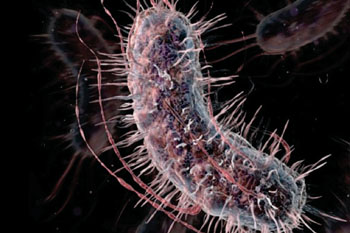Next-Generation Whole-Cell Biosensors May Provide New Approach to Diagnostics
By LabMedica International staff writers
Posted on 09 Jun 2015
Researchers have developed the first programmable bacterial cells for medical diagnosis with improved computing and amplification capacity that could enable earlier clinical detection of various pathological biomarkers in urine or blood.Posted on 09 Jun 2015
Several hurdles have limited the application of whole-cell biosensors as analytical clinical tools, primarily their unreliable operation in complex samples and low signal-to-noise ratio. Teams led by Jerome Bonnet (INSERM, CNRS; Montpellier University; Montpellier, France), Franck Molina (SysDiag, CNRS; Montpellier, France), in association with teams led by Eric Renard (Montpellier Regional University Hospital; Montpellier, France) and Drew Endy (Stanford University; Standford, CA, USA), have transformed bacteria into diagnostic agents by inserting the equivalent of a computer program into their DNA. These “bactosensors” with genetically encoded digital amplifying genetic switches can detect clinically relevant molecular markers. They perform signal digitization and amplification, multiplexed signal processing via Boolean logic gates, and data storage.
In vitro diagnostic (IVD) tests are generally noninvasive and simple, but some are complex, requiring sophisticated technologies often available only in central laboratories. Living cells can detect, process, and respond to many signals. Provided with an appropriate “program” they can accomplish diagnostic tasks. To do this, Jerome Bonnet’s team at had the idea to apply concepts from synthetic biology derived from electronics to construct genetic systems to “program” living cells like a computer.
As a central component of modern electronic instruments (including calculators and smartphones), the transistor acts both as a switch and a signal amplifier. In informatics, several transistors are combined to construct “logic gates” that respond to different signal combinations according to a predetermined logic. For example, a dual input “AND” logic gate will produce a signal only if both of two input signals are present. At Standford University Jerome Bonnet had previously invented a genetic transistor named the “transcriptor.” Inserting transcriptors into bacteria can transform them into calculators, where electrical signals used in electronics are replaced by molecular signals that control gene expression. It is thus possible to reprogram the cells by implanting simple genetic “programs” as sensor modules that enable cells to respond to specific combinations of molecules.
The team now applied this new technology to detect disease “signals” in clinical samples. The transcriptor amplification ability was used to detect biomarkers even at very small amounts, and the test results were successfully stored in the bacterial DNA for several months. Thus, the semi-synthetic cells acquired the ability to perform different functions based on the presence of several markers, opening the way to more accurate diagnostic tests that rely on detection of molecular “signatures” using different biomarkers.
As a proof-of-concept clinical experiment, the transcriptor was connected to a bacterial system that responds to glucose and successfully detected the abnormal levels of glucose in urine of diabetic patients.
“We have standardized our method, and confirmed the robustness of our synthetic bacterial systems in clinical samples. We have also developed a rapid technique for connecting the transcriptor to new detection systems. All this should make it easier to reuse our system,” said first author Alexis Courbet, “Our work is presently focused on the engineering of artificial genetic systems that can be modified on demand to detect different molecular disease markers,” said Jerome Bonnet.
The study, by Courbet A, et al., was published May 27, 2015, in the journal Science Translational Medicine.
Related Links:
INSERM















